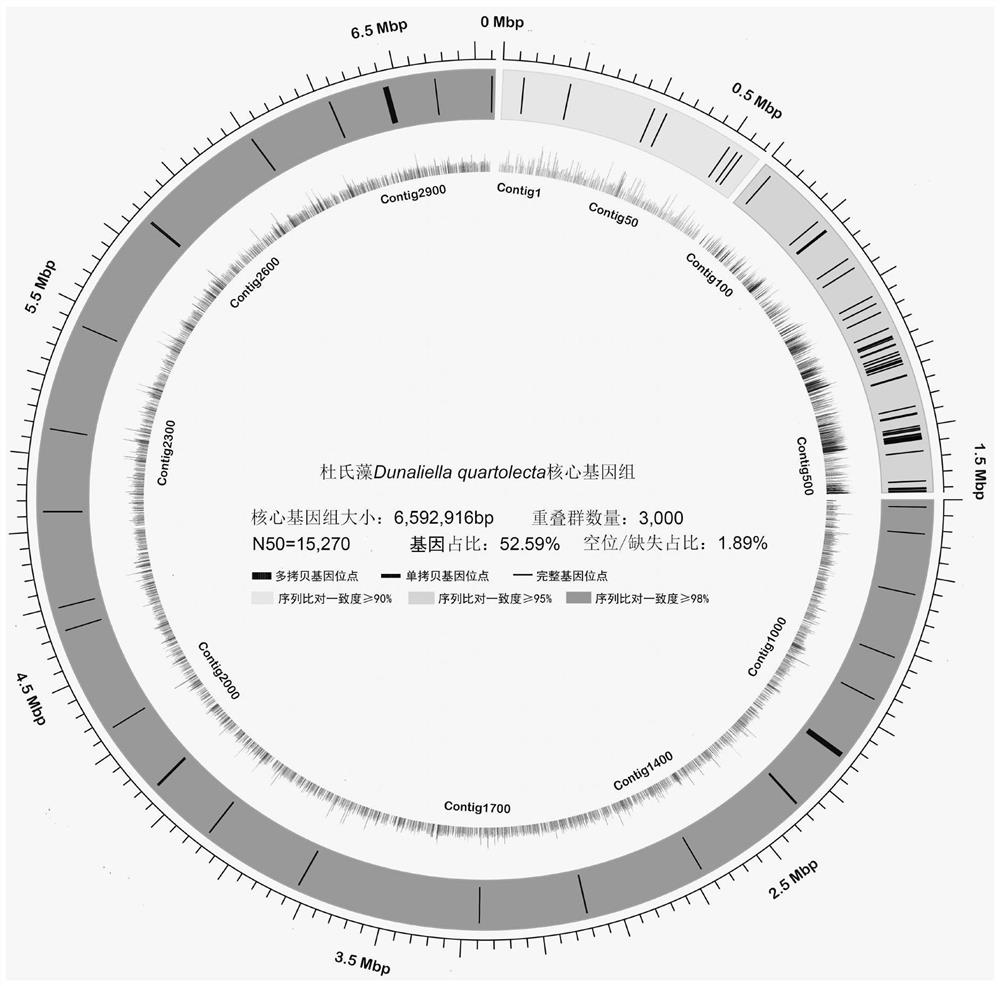A method for strain identification based on a Dunaliella core genome sequence
A technology of genome sequence and Dunaliella, which is applied in the field of plant molecular identification, can solve the problems of long, non-existent, and time-consuming results, shorten data comparison time, improve data acquisition efficiency, and improve accurate identification efficiency. Effect
- Summary
- Abstract
- Description
- Claims
- Application Information
AI Technical Summary
Problems solved by technology
Method used
Image
Examples
Embodiment 1
[0050] A method for whole genome sequencing of Dunaliella D.quartolecta and de novo assembly of core genome sequence fragments, comprising the following steps:
[0051] In step 1, a single clone of the algal cells of a strain of Dunaliella D.quartolecta is picked under aseptic conditions, and after passing the microscope inspection, the indoor expansion culture is carried out under aseptic conditions. The indoor expansion culture conditions are: the photoperiod is 18h: 6h, light intensity is 19000lx, temperature: 23±3℃, keep sterile and ventilated environment, shake the petri dish every 5 days to prevent algal cells from adhering to the wall, and take 0.5~1mL of algal fluid for microscopic examination, the culture period is 28 ± 7 days, prepare the following medium solution to carry out indoor expansion cultivation of the algal strain to be tested, and the medium formula is as follows:
[0052] 30g / L NaCl, 1.5g / L NaNO 3 , 1.4g / L K 2 HPO 4 , 1.75g / L MgSO4 7H 2 O, 1.36g / LCaC...
Embodiment 2
[0123] A method for strain identification using the core genome sequence of Dunaliella D.quartolecta, comprising the following steps:
[0124]Step 1, sample collection, purification and culture: collect the algal strain to be tested (tentatively named Dunaliella sp.), and purify the algal strain to be tested for indoor expansion culture. The single clones were picked under the conditions, and after passing the microscope inspection, the indoor expansion culture was carried out under aseptic conditions. The indoor expansion culture conditions were: the photoperiod was 18h: 6h, the light intensity was 19000lx, the temperature: 23±3℃, and the sterile conditions were maintained. In a ventilated environment, shake the petri dish every 5 days to prevent algal cells from adhering to the wall, and take 0.5-1 mL of algal fluid for microscopic examination. The culture period is 28±7 days. To expand the culture, the medium formula is as follows:
[0125] 30g / L NaCl, 1.5g / L NaNO 3 , 1.4...
Embodiment 3
[0170] Taking the core genome data of Dunaliella D.quartolecta as a reference, the genetic variation and evolutionary characteristics of an identified algal strain Dq_SX genome were analyzed, including the following steps:
[0171] Step 1, with reference to the method for screening and assembling the Dunaliella D.quartolecta core genome sequencing data constructed by the present invention (see Example 1), utilize SOAP de novo 2.04 software to perform a complete analysis of an identified Dunaliella strain (tentatively named Dq_SX). The genome sequencing data was subjected to core fragment screening and de novo assembly (for methods, see Examples 1 and 2).
[0172] Step 2, use LASTZ 1.02.00 software to perform collinearity analysis on the Dunaliella Dq_SX core genome assembly data constructed in step 1, to obtain repeating fragments ( Image 6 ).
[0173] Step 3, take the Dunaliella D.quartolecta core genome sequence constructed by the present invention as a reference template,...
PUM
 Login to View More
Login to View More Abstract
Description
Claims
Application Information
 Login to View More
Login to View More - R&D
- Intellectual Property
- Life Sciences
- Materials
- Tech Scout
- Unparalleled Data Quality
- Higher Quality Content
- 60% Fewer Hallucinations
Browse by: Latest US Patents, China's latest patents, Technical Efficacy Thesaurus, Application Domain, Technology Topic, Popular Technical Reports.
© 2025 PatSnap. All rights reserved.Legal|Privacy policy|Modern Slavery Act Transparency Statement|Sitemap|About US| Contact US: help@patsnap.com



